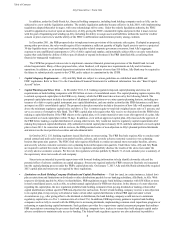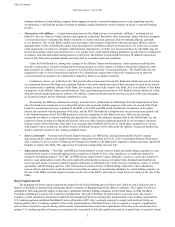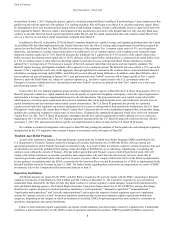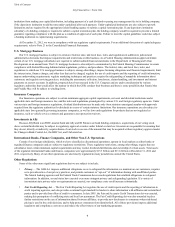Ally Bank 2012 Annual Report Download - page 18
Download and view the complete annual report
Please find page 18 of the 2012 Ally Bank annual report below. You can navigate through the pages in the report by either clicking on the pages listed below, or by using the keyword search tool below to find specific information within the annual report.16
We have significant maturities of unsecured debt each year. While we have reduced our reliance on unsecured funding, it continues to
remain a critical component of our capital structure and financing plans. At December 31, 2012, approximately $1.3 billion in principal
amount of total outstanding consolidated unsecured debt is scheduled to mature in 2013, and approximately $5.6 billion and $5.1 billion in
principal amount of consolidated unsecured debt is scheduled to mature in 2014 and 2015, respectively. We also obtain short-term funding
from the sale of floating rate demand notes, all of which the holders may elect to have redeemed at any time without restriction. At December
31, 2012, a total of $3.1 billion in principal amount of Demand Notes were outstanding. We also rely on secured funding. At December 31,
2012, approximately $11.5 billion of outstanding consolidated secured debt is scheduled to mature in 2013, approximately $13.6 billion is
scheduled to mature in 2014, and approximately $8.6 billion is scheduled to mature in 2015. Furthermore, at December 31, 2012,
approximately $15.7 billion in certificates of deposit at Ally Bank are scheduled to mature in 2013, which is not included in the 2013
unsecured maturities provided above. Additional financing will be required to fund a material portion of the debt maturities over these
periods. The capital markets continue to be volatile, and Ally’s access to the debt markets may be significantly reduced during periods of
market stress. In addition, we will continue to have significant original issue discount amortization expenses (OID expense) in the near future,
which will adversely affect our net income and resulting capital position. OID expense was $349 million in 2012, and the remaining
scheduled amortization of OID is $261 million, $188 million, and $56 million in 2013, 2014, and 2015, respectively.
As a result of the volatility in the markets and our current unsecured debt ratings, we have increased our reliance on various secured debt
markets. Although market conditions have improved, there can be no assurances that this will continue. In addition, we continue to rely on our
ability to borrow from other financial institutions, and many of our primary bank facilities are up for renewal on a yearly basis. Any weakness
in market conditions and a tightening of credit availability could have a negative effect on our ability to refinance these facilities and increase
the costs of bank funding. Ally and Ally Bank also continue to access the securitization markets. While markets have continued to stabilize
following the 2008 liquidity crisis, there can be no assurances these sources of liquidity will remain available to us.
Our indebtedness and other obligations are significant and could materially and adversely affect our business.
We have a significant amount of indebtedness. At December 31, 2012, we had approximately $82.8 billion in principal amount of
indebtedness outstanding (including $45.1 billion in secured indebtedness). Interest expense on our indebtedness constituted approximately
48% of our total financing revenue and other interest income for the year ended December 31, 2012. In addition, during the twelve months
ending December 31, 2012, we declared and paid preferred stock dividends of $802 million in the aggregate.
We have the ability to create additional unsecured indebtedness. If our debt service obligations increase, whether due to the increased
cost of existing indebtedness or the incurrence of additional indebtedness, we may be required to dedicate a significant portion of our cash
flow from operations to the payment of principal of, and interest on, our indebtedness, which would reduce the funds available for other
purposes. Our indebtedness also could limit our ability to withstand competitive pressures and reduce our flexibility in responding to
changing business and economic conditions.
The worldwide financial services industry is highly competitive. If we are unable to compete successfully or if there is increased
competition in the automotive financing and/or insurance markets or generally in the markets for securitizations or asset sales, our business
could be negatively affected.
The markets for automotive financing, banking, and insurance are highly competitive. The market for automotive financing has grown
more competitive as more consumers are financing their vehicle purchases and as more competitors continue to enter this market as a result of
how well automotive finance assets generally performed relative to other asset classes during the 2008 economic downturn. More recently,
competition for automotive financing has further intensified as a growing number of banks have become increasingly interested in
automotive-finance assets, which has resulted in pressure on our net interest margins. For example, on April 1, 2011, TD Bank Group
announced the closing of its acquisition of Chrysler Financial, which could enhance Chrysler Financial’s ability to expand its product
offerings and may result in increased competition. Ally Bank faces significant competition from commercial banks, savings institutions,
mortgage companies, and other financial institutions. Our insurance business faces significant competition from insurance carriers, reinsurers,
third-party administrators, brokers, and other insurance-related companies. Many of our competitors have substantial positions nationally or
in the markets in which they operate. Some of our competitors have lower cost structures, substantially lower costs of capital, and are much
less reliant on securitization activities, unsecured debt, and other public markets. Our competitors may be subject to different, and in some
cases, less stringent, legislative and regulatory regimes than we are, thus putting us at a competitive disadvantage to these competitors. We
face significant competition in most areas including product offerings, rates, pricing and fees, and customer service. If we are unable to
compete effectively in the markets in which we operate, our profitability and financial condition could be negatively affected.
The markets for asset securitizations and whole-loan sales are competitive, and other issuers and originators could increase the amount of
their issuances and sales. In addition, lenders and other investors within those markets often establish limits on their credit exposure to
particular issuers, originators, and asset classes, or they may require higher returns to increase the amount of their exposure. Increased
issuance by other participants in the market or decisions by investors to limit their credit exposure to (or to require a higher yield for) us or to
automotive securitizations or whole-loans could negatively affect our ability and that of our subsidiaries to price our securitizations and
whole-loan sales at attractive rates. The result would be lower proceeds from these activities and lower profits for our subsidiaries and us.
Table of Contents
Ally Financial Inc. • Form 10-K
























